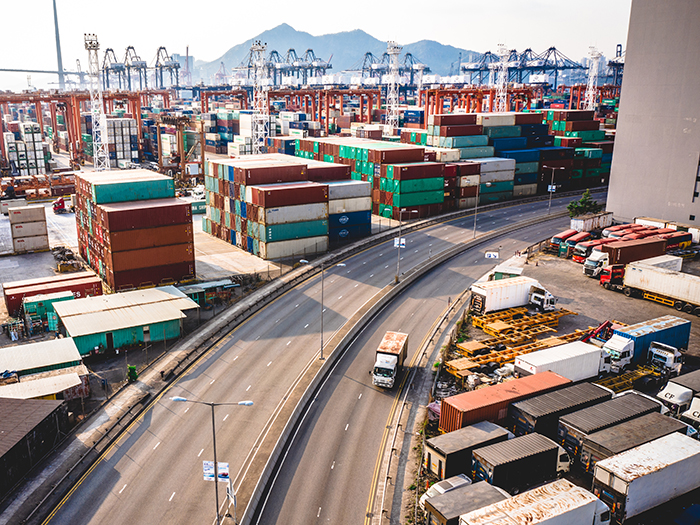The ‘Bullwhip’ Effect: What It Is and How It’s Exacerbating Supply Chain Issues

Cargo delays, a trucking labor shortage, and continued pandemic shutdown measures are exacerbating supply chain woes. The dynamic is leading to empty shelves and panic buying, which is creating even more headaches for those trying to manage inventories.
Nick Kohlhof, account executive in property casualty for Holmes Murphy in Des Moines, said many companies are repeating a behavior that was witnessed among consumers at the start of the pandemic: Fearing shortages, they stockpiled necessities like toilet paper.
Pandemic panic buying led to shortages up the supply chain and is representative of “The Bullwhip Effect,” a phrase coined by MIT professor Jay Forrester.
He first described the phenomenon that refers to increased demand at the end of a supply chain causing a ripple effect and distortions throughout the chain.
Supply Challenges Today
A company’s purchasing practices also can have a major impact on insurance coverage and costs. More inventory means there’s more product to insure and more warehouse space could add another property to a policy.
Having a smoothly working supply chain is a competitive advantage for business. It allows them to stock only what they need, keeping costs low.
“The buying frenzy only makes things more complicated and unpredictable,” said Kohlhof.
He also has noticed that companies are trying to anticipate or deal with supply chain delays by stockpiling inventory, which makes it more challenging to predict inventory values and come up with appropriate coverage limits.
“Lead time for products, inventory on hand and supply chain interruptions are all taken into consideration and impact policy structure and coverage requirements,” he said.
Talk to Your Broker
When a company increases its inventory or opens a new warehouse, it should also be communicating with its insurance broker about these changes.
“Expanding into new warehouse space, increasing on-site inventory, or developing new product lines are positives for businesses,” he said.
“However, when these changes aren’t properly reported to your insurance broker, businesses face uncovered insurance claims.”
In today’s unpredictable environment, Kohlhof said a traditional yearly review with a broker is often not enough to make sure insurance coverages are sufficient to cover a warehouse or inventory fire, flood or theft loss.
Risk Management’s Hand in Helping
While updating insurance coverages might not be top of mind during such a challenging time, Kohlhof said risk managers should drive home the idea that it should be a priority. He makes it a point to keep in touch with clients on a frequent basis about how their purchasing and inventory approaches are affecting their insurance needs.
He added that businesses also need to make sure their inventory and facilities are well protected against loss.
Brendan Neligan, ocean cargo broker with Risk Placement Services, said businesses that are stockpiling inventories need to mitigate risk at their facilities.
Businesses should determine if their facilities are clean and well maintained; whether they are protected against theft with cameras, water detectors or other security measures; and they have fire protection equipment such as sprinkler systems or smoke alarms in place.
Neligan said it is crucial for businesses to consider worst case scenarios that could cause inventory losses and put measures in place to prevent them.
Showing an underwriter that inventory, even though it may be expanding, is well protected can affect the rates a company will pay for insurance coverage.
“Inventories are rising and there will be costs associated with that, but businesses can defray some of those costs by understanding their risks and mitigating losses,” he said.
Neligan said underwriters often estimate the value of losses based on industry averages. But those may not be sufficient at a time when companies are keeping large inventories on hand. It’s up to businesses to have a clear idea of what they are holding and communicate that.
“It’s very important that businesses know what they are on the hook for,” he said. “They should have the maximum policy limits in place for what they are holding at any particular time.”
Shipping Costs Rising
Neligan said insurance is only one of the rising costs related to the supply chain; the cost of a shipping container traveling from East Asia to the U.S. increased dramatically during the pandemic, he said.
A container that might hold 1,000 pairs of shoes or 100 TVs used to rent for between $2,500 and $5,000. Today, it costs $15,000. The time frame for shipping from East Asia to the U.S. is also up. It used to be about 40 days and now is about 75.
“It’s taking double the time and five times the cost,” he said.
With such concerns, it might be tempting to consider foregoing other additional costs such as paying for an increase in insurance coverage or footing the bill for taking risk mitigation measures at a warehouse.
He urges businesses not to follow that course, particularly as supply chain issues are expected to drag further into 2022 and perhaps even beyond.
He added the pandemic has prompted more consumers to shop online. He doesn’t expect that trend to reverse.
“It’s a rock going down a hill,” he said. “It’s gaining momentum.”
The best advice he has to offer is for businesses to make sure they know the maximum inventory on hand at any point, to talk with their broker about it, and to insure it appropriately.
“You should have a deep discussion with an insurance broker and figure out what you need,” he said.
“Seek a broker, and a second opinion, if needed. These are people working in the trenches every day. Use their knowledge and experience to your advantage.” &










